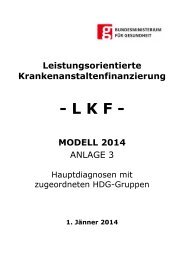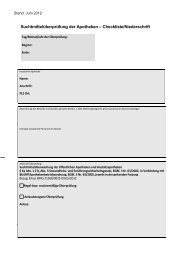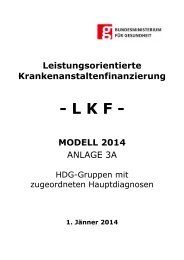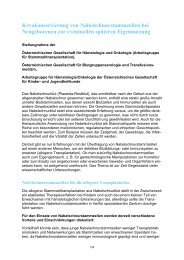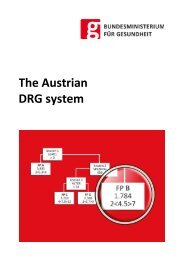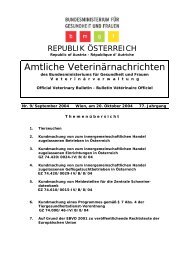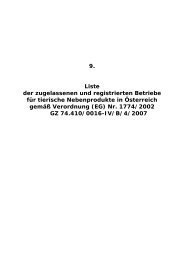Report on the Drug Situation 2010 - Bundesministerium für ...
Report on the Drug Situation 2010 - Bundesministerium für ...
Report on the Drug Situation 2010 - Bundesministerium für ...
Create successful ePaper yourself
Turn your PDF publications into a flip-book with our unique Google optimized e-Paper software.
Table 6.1<br />
Data <strong>on</strong> hepatitis B, hepatitis C-Ab, hepatitis C-RNA and HIV infecti<strong>on</strong> rates, in 2009<br />
Data source HBV rate HCV-Ab rate HIV rate<br />
Lukasfeld treatment department 23% (14/60) 1 33% (20/60) 3% (2/60)<br />
L<strong>on</strong>g-term treatment department at<br />
18% (15/82) 2 43% (35/82) 0% (0/82)<br />
Ant<strong>on</strong> Proksch Institute (API)<br />
Low-threshold centre Ganslwirt 9% (5/55) 3 70% (51/74) 0% (0/ 79)<br />
Caritas Marienambulanz outpatient department 15% (19/123) 4 70% (86/123) 1% (1/123)<br />
DOKLI 5 14% (45/332) 55% (238/435) 2% (8/424)<br />
<strong>Drug</strong>-related deaths (intoxicati<strong>on</strong>s) 2009 n.a. 18% (34/187) 5<br />
45% (34/76)<br />
5% (9/187)<br />
12% (9/76)<br />
1 This percentage relates to pers<strong>on</strong>s in whom antibodies to hepatitis B were found and whose medical history<br />
did not indicate hepatitis B vaccinati<strong>on</strong>s.<br />
2 This percentage relates to pers<strong>on</strong>s in whom antibodies to hepatitis B were found and for whom it was<br />
established that <strong>the</strong>y had not received vaccinati<strong>on</strong>s or been cured.<br />
3 This percentage relates to pers<strong>on</strong>s in whom hepatitis B antibodies or antigens were found and who had not<br />
yet received hepatitis B vaccinati<strong>on</strong>s.<br />
4 This percentage relates to pers<strong>on</strong>s in whom both HBVc and HBVs antibodies were found. People who tested<br />
positive <strong>on</strong>ly for antiHBVs were excluded because this results from HBV vaccinati<strong>on</strong>s.<br />
5 Only 76 out of a total number of 187 expert opini<strong>on</strong>s <strong>on</strong> directly drug-related deaths explicitly menti<strong>on</strong>ed<br />
<strong>the</strong> presence or absence of HCV Ab or HIV infecti<strong>on</strong>s. In <strong>the</strong> remaining cases it is not clear whe<strong>the</strong>r no tests<br />
for <strong>the</strong> relevant infecti<strong>on</strong>s were carried out or whe<strong>the</strong>r <strong>the</strong> results were negative and thus not menti<strong>on</strong>ed. The<br />
two percentages given <strong>the</strong>refore indicate maximum and minimum levels of HCV and HIV infecti<strong>on</strong> prevalence<br />
rates.<br />
Sources: Duspara, Stolz-Gombocz, Haltmayer, Anderwald, Bauer, pers<strong>on</strong>al communicati<strong>on</strong>s;<br />
GÖG/ÖBIG <strong>2010</strong>a, GÖG/ÖBIG <strong>2010</strong>c; see also ST9; representati<strong>on</strong> by GÖG/ÖBIG<br />
For Vienna, data <strong>on</strong> drug-related infectious diseases that have been obtained from<br />
cases histories are given in <strong>the</strong> secti<strong>on</strong> <strong>on</strong> current health problems of <strong>the</strong> BADO report<br />
(see Table A29 in <strong>the</strong> Annex; IFES 2009b). The informati<strong>on</strong> provided by clients for<br />
Vienna’s BADO documentati<strong>on</strong> indicates a HCV prevalence rate of 29% and a HBV prevalence<br />
rate of 3%, i.e., prevalence has remained at a level similar to previous years.<br />
HIV prevalence, also based <strong>on</strong> informati<strong>on</strong> by <strong>the</strong> clients <strong>the</strong>mselves, has hardly<br />
changed as well: it is 4% now (IFES 2009b). An almost linear correlati<strong>on</strong> between rises<br />
in hepatitis C infecti<strong>on</strong>s and age of clients has shown: while <strong>the</strong> prevalence rate is 10%<br />
am<strong>on</strong>g clients under 21, it goes up to 40% am<strong>on</strong>g clients over 30. Because of <strong>the</strong> study<br />
design, it is not possible to distinguish between positive test results for HCV antibodies<br />
and a positive HCV RNA status.<br />
No data from <strong>the</strong> official reporting statistics of infectious diseases relating to <strong>the</strong><br />
general populati<strong>on</strong> have yet been available for 2009 (see GÖG/ÖBIG 2009b).<br />
56 © GÖG/ÖBIG, <str<strong>on</strong>g>Report</str<strong>on</strong>g> <strong>on</strong> <strong>the</strong> <strong>Drug</strong> Situati<strong>on</strong> <strong>2010</strong>



